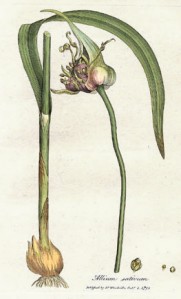Gustatory Garlic

Also known as Allium sativum
Most of us are familiar with garlic. It’s used in so many yummy recipes. Yet when sick many people tend to forget this important little flavour packed ingredient.
Garlic has many uses. What can it do?
• It is an antioxidant
• It can aid the body to rid itself of arsenic and methylmercury
• It can aid in lowering cholesterol
• It’s useful in cases of high blood pressure
• It promotes the health of cardiovascular system
• It has wonderful antimicrobial properties
• It is useful for dealing with certain parasites
• It causes cancer cell death in some forms of cancer
• It increases bioavailability of iron, folate, and zinc
• It has anti inflammatory properties too
Some of the ways that I often use it is as an infused oil – garlic infused into olive oil. This is great to have around for cooking too. I’ve used garlic oil mixed with St John’s Wort (SJW) oil in my dog’s ears when she got an ear infection. The garlic helps with the infection, while the SJW oil helps with the discomfort. Garlic oil is also nice when you have a “chest cold” – just rub it into the chest much like a vapour rub. This can be an especially useful application for people who can’t eat much garlic or don’t like the taste.
There have been some concerns voiced about botulism and garlic oil, and this is a valid concern. If your cooking with it, it’s not as big a problem since heat kills the spores. However, it is still best to be very careful in your preparation. Treat it much like making jams and jellies. Keep your tools clean, you can do a hot water bath of the finished (and lidded) product, and it should be stored in the fridge. I also tend to add things like organic grapefruit seed extract to it.
A couple other things to be cautious about with garlic: it is a blood thinner. If you are going for surgery, including dental work, you may want to stop taking garlic for a while before hand. At least two weeks is the general recommendation. If you already take blood thinners (incl. baby aspirin) you would be wise to check with your health care providers – ideally, have your herbalist and physician work together. The other caution is about dogs. More and more “holistic” dog foods are putting garlic in their foods. While garlic can be useful for dogs, too much garlic (or onions) can be bad for dogs. In some dogs it can cause something called Heinz Body Anemia. Symptoms to watch for include: paleness of the gums and tongue, and lowered energy. The blood thinning action can also cause similar symptoms. Reducing the dose, or removing the garlic all together should allow the dog to return to normal.
I’m lucky enough that I can eat garlic by the clove. Just peal a clove, pop it in my mouth and chew. One three times a day, if you can stand it, is what I use for people with “chest colds”. I’ve heard the complaint “but I’ll smell like garlic”. Let’s face it, who cares? Your sick, and no one wants what you’ve got anyway. A few days at home smelling like garlic and getting better beats not smelling like garlic and being sick longer.
Another way I like to use garlic is as part of a protocol for people with digestive issues. It is a wonderful tool for rebalancing intestinal (healthy) bacteria populations. It’s amazing what just this one protocol can do! A client who used it reported that they were able to get off their prescription medication, for high stomach acid (a proton pump inhibitor) – they were no longer having the symptoms that had been the reason for the prescription.
Do you have a favorite way to use garlic? I’d love to hear it.
~ Elizabeth
To learn more about the benefits of garlic click here
References:
- Plant Foods Hum Nutr. 2009 Dec;64(4):244-9.
- Phytother Res. 2010 Mar;24(3):374-8
- Food and Chemical Toxicology, DOI: 10.1016/j.fct.2007.09.108
- issue 2638 of New Scientist magazine, 14 January 2008, page 14
- Food Chem toxicol. 2010 Jan;48(1):417-21.
- J Nutr. 2009 Nov;139(11):2055-60.
- J Atheroscler Thromb 2008 Dec;15(6):334-8.
- Bratisl Lek Listy. 2010;111(8):452-6.
- Hypertens Res 2009 Jun;32(6):433-7
- Ann Pharmacother 2008 Dec;42(12):1766-71.
- Maturitas. 2010 Oct;67(2):144-50.
- Pharmacology 2009;83(4):197-204.
- Lipids Health Dis 2010 Oct 19;9:119
- Eur J Nutr 2009 Mar;48(2):120-3.
- FEMS Microbiol Lett. 2010 Feb;303(2):183-9
- Indian J Med Res 2010 Jun;131:809-13.
- J Vector Borne Dis. 2010 Sep;47(3):160-7.
- Bioorg Med Chem Lett 2010 Sep 15;20(18):5541-3
- Anticancer Drugs 2009 Sep;20(8):702-12.
- Nutr. Cancer 2010 Oct;62(7):947-57.
- Mol Cancer Res 2009 Jun;7(6):870-9
- J Nutr. 2009 Jan;139(1):106-12
- J Agric Food Chem. 2010 Jul 28;58(14):8426-9
- Nutr. Res. 2010 Feb;30(2):85-95
- Arthritis Res Ther 2009;11(5):R145.

